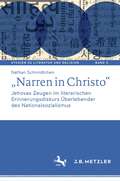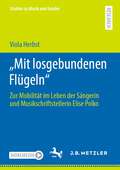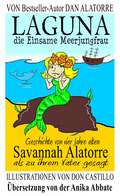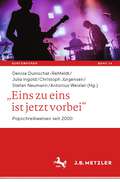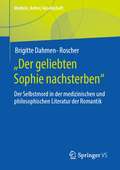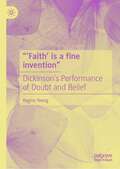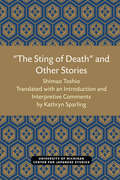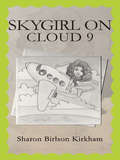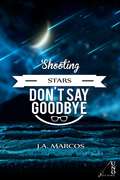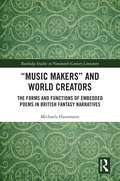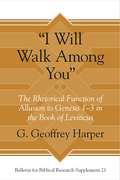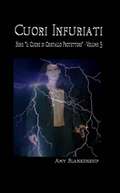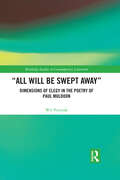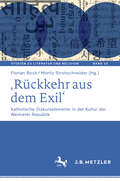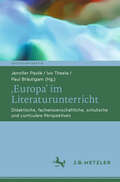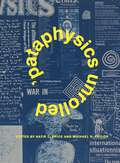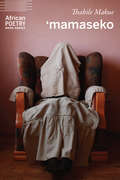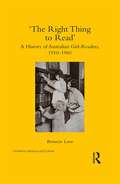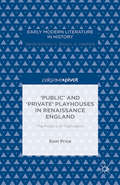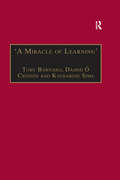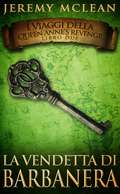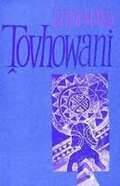- Table View
- List View
„Narren in Christo“: Jehovas Zeugen im literarischen Erinnerungsdiskurs Überlebender des Nationalsozialismus (Studien zu Literatur und Religion / Studies on Literature and Religion #5)
by Nathan SchmidtchenDie vorliegende Studie ist die erste, die den Erinnerungsspuren nachgeht, die Jehovas Zeugen (Bibelforscher) in den Erzähltexten Überlebender des Nationalsozialismus hinterlassen haben. Trotz unterschiedlicher Erinnerungskulturen und -interessen seitens der Autoren ergibt sich ein einheitliches und zugleich schillerndes Bild. Häufig nur Erzählobjekte ohne eigene Stimme, bleiben sie randständig, andersartig und widersprüchlich. Jehovas Zeugen faszinieren, befremden und stören. Als Heilige, Propheten, Märtyrer, Samariter und Sündenböcke stehen sie in der Nachfolge des Sohnes Gottes. Bezüge ergeben sich auch zur Figur des christlichen Narren: nicht von dieser Welt, der Welt des nationalsozialistischen Terrors, aber zugleich in ihr und gegen sie zeugend.
„Mit losgebundenen Flügeln“: Zur Mobilität im Leben der Sängerin und Musikschriftstellerin Elise Polko (Studien zu Musik und Gender)
by Viola HerbstDass heutzutage noch jemand die „Märchenprinzessin“ Elise Polko (1823-1899) kennt, ist vermutlich eher die Ausnahme. In der zweiten Hälfte des 19. Jahrhunderts allerdings war sie durch ihr kulturelles Handeln enorm präsent. Zunächst hatte sie in Leipzig unter Felix Mendelssohn Bartholdy eine Gesangslaufbahn eingeschlagen. Später widmete sie sich als Schriftstellerin bekannten Persönlichkeiten aus der Welt der Musik und erlangte gleich mit ihrem Debüt, den Musikalischen Märchen (1852), ein großes Publikum.Die vorliegende biografische Studie macht Elise Polko wieder sichtbar, wobei sie die Mobilität – verstanden als Bewegung und Beweglichkeit – als kulturwissenschaftliche Perspektive einnimmt. Ihre Gesundheit, Vorbehalte gegenüber schreibenden Frauen, der Beruf ihres Mannes bei der Eisenbahn oder fehlendes Geld mögen Elise Polko eingeschränkt haben, sodass sie nicht immer „mit losgebundenen Flügeln“ unterwegs war. Letztlich entsteht aber das Bild einer bemerkenswerten, eigenständigen und vor allem flexiblen Frau, die allen Umständen zum Trotz am Musikleben des 19. Jahrhunderts partizipierte und dieses mitgestaltete, jedoch in einer werkzentrierten Musikgeschichtsschreibung bislang keine Rolle gespielt hat.
„Laguna, die Einsame Meerjungfrau“
by Dan Alatorre Anika AbbateZusammenfassung von "Laguna, die einsame Meerjungfrau" Das entzückende Bilderbuch mit vielen niedlichen Bildern, Laguna, die Einsame Meerjungfrau, erzählt die Geschichte einer jungen Meerjungfrau, die einen kreativen Weg finden muss, gestrandete Piraten zu retten. Indem sie anderen hilft, gewinnt sie neue Freunde. Schön für Eltern, die es ihren Vorschülern vorlesen oder für etwas ältere Kinder, die es ihren Eltern vorlesen wollen!
„Eins zu eins ist jetzt vorbei“: Popschreibweisen seit 2000 (Kontemporär. Schriften zur deutschsprachigen Gegenwartsliteratur #14)
by Christoph Jürgensen Antonius Weixler Julia Ingold Stefan Neumann Denise Dumschat-RehfeldtDer Band nimmt das titelgebende Tocotronic-Zitat zum heuristischen Ausgangspunkt, um das Verhältnis von Kunst und Wirklichkeit und damit den Entwurf von ‚Realität‘ insgesamt in deutschsprachigen Popschreibweisen seit 2000 zu untersuchen. Während das literarische Feld sich in der Folge von 9/11 etwa tendenziell zu einem „Relevanten Realismus“ bekannte, wandte sich die Hamburger Schule in den frühen 2000er Jahren eher einer ästhetizistischen Hochkunstphase zu. Seit den 2010er Jahren lässt sich wiederum eine neue Welle ‚relevant realistischer‘, politisch-engagierter Popsongs erkennen.
„Der geliebten Sophie nachsterben“: Der Selbstmord in der medizinischen und philosophischen Literatur der Romantik (Medizin, Kultur, Gesellschaft)
by Brigitte Dahmen-RoscherForschung und Behandlungsmethoden der psychiatrisch tätigen Ärzte in der Zeit der Romantik wurden von der Philosophie des deutschen Idealismus, der romantischen Bewegung mit ihrer naturphilosophisch orientierten Weltsicht und den Erkenntnissen der aufgeklärten französischen Psychiater geprägt. Die „Psychiker“ vertraten die Ansicht, bei der Selbstmordneigung sei die Seele erkrankt, für die „Somatiker“ stellte sie sich als Folge einer körperlichen Erkrankung dar. Es wird ein Bogen geschlagen zu den Selbstmordtheorien im 20. und 21. Jahrhundert; dabei wird deutlich, dass einige Ideen und Vorstellungen überraschend aktuell geblieben sind.
“‘Faith’ is a fine invention”: Dickinson’s Performance of Doubt and Belief
by Regina YoongThis book covers nineteenth-century American poet Emily Dickinson who captured the multifaceted nature of life in all of its uncertainties. Studies on her exploration of faith are ample, but in this book, the author uncovers Dickinson’s playful role-play in enacting solemn themes of religion, death, and the unknown. Dickinson’s creativity encompasses not only her use of language but also her poetic personae and self-created poetic stages inviting readers to question, contemplate deeply or even poke fun at life's absurdities. By using performative roles such as the rejected outcast, passive supplicant, and playful warrior, Dickinson unveils--through a paradoxical framework of belief and unbelief-- a line of inquiry that is multifocal and erratic to “tell all the truth and tell it slant.”
“The Sting of Death” and Other Stories (Michigan Papers in Japanese Studies #12)
by Toshio Shimao“The Sting of Death” and Other Stories
“Skygirl On Cloud 9”
by Sharon Birlson Kirkham"Skygirl On Cloud 9" is an entertaining narrative of the amazing globe-trekking adventures of fllight attendant Sharon Birlson Kirkham. Each amusing account recalls one of the exciting opportunities Sharon and her husband Cary have experienced through-out her career, and since. While she says they've done their best to see as much as possible, "the world is a really big place. There are hundreds more trips to be taken and stories to be written, 'but' there are only 365 days in a year...."
“SHOOTING STARS DON’T SAY GOODBYE”
by J. A. MarcosEmily is 23 years old, history teacher and lives with her parents and her younger brother, Jason. It would all be perfect in her life if there wasn’t one small detail: She is blind. Even though, she became an independent girl that despite the difficulties overcame her blindness and is able to have a normal life. However, Emily still has difficulties to maintain her romantic relationships, due to prejudices against getting involved with men who differ in her lifestyle. But destiny will place Matthew on her way, her newest neighbor: young, handsome, with thirst for living. With 21 years old, Matt, how he likes to be called, loves riding his motorcycle, has a tattoo that covers the entire arm and he has just got enchanted by the rare beauty of Ems. She is all that he always wanted; he is the opposite of all she ever imagined to want. It’s a fun romance with touches of humor and a little bit of drama. A big life lesson, showing in its context the difficulties of living in a society that is not prepared to embrace people with disabilities. “Shooting stars don’t say goodbye” brings an engaging story, narrated on the point of view of the protagonist herself, with a surprise ending, capable of making you get emotional, cry and cheer.
“Music Makers” and World Creators: The Forms And Functions Of Embedded Poems In British Fantasy Narratives (Routledge Studies in Nineteenth Century Literature)
by Michaela HausmannMany works of fantasy literature feature a considerable number of embedded poems, some written by the authors themselves, some borrowed and transformed from other authors. Exploring the mechanisms of this mix and the interaction between individual poems and the overall narrative, this monograph analyses the various forms and functions of embedded poems in major works of fantasy literature. The choice of authors and texts shed light on the development of fantasy as a genre that frequently mixes prose and verse and thus continues the long tradition of prosimetric practices after the Romantic period. Not only does the analysis of the embedded poems allow for a new understanding of the individual works. It also promises insights into shared literary-historical roots, cross-influences between the authors and the role of the mix of poetry and prose for the imaginative and subversive potential of fantasy literature in general. Providing comprehensive case studies of the forms and functions of embedded poems in fantasy literature, this volume illuminates the emergence of modern fantasy and its impact on contemporary fantasy.
“I Will Walk Among You”: The Rhetorical Function of Allusion to Genesis 1–3 in the Book of Leviticus (Bulletin for Biblical Research Supplement)
by G. Geoffrey HarperThe well-known parallels between Genesis and Leviticus invite further reflection, particularly in regard to the rhetorical and theological purpose of their lexical, syntactical, and conceptual correspondences. This volume investigates the possibility that the final-form text of Leviticus is an indirect reference to Genesis 1–3 and examines the rhetorical significance of such an allusion.The face of Pentateuch scholarship has shifted dramatically in the last forty years, resulting in the questioning of many received truths and the employment of a host of new, renewed, and often competing methodologies by biblical scholars. This study sits at the intersection of these recent interpretive trends. G. Geoffrey Harper uses insights from the fields of intertextuality, rhetorical criticism, and speech act theory to create a methodological framework, which he applies to three Leviticus pericopes. Chapters 11, 16, and 26 are examined in turn, and for each the assessment of potential parallels at lexical, syntactical, and conceptual levels reveals a complex web of interconnected allusion to the creation and Eden narratives of Genesis 1 and 2–3. Moreover, Harper probes the theological and rhetorical import of these intertextual connections and explores how Leviticus ought to be understood in its Pentateuchal context.This comprehensive study of the connections between these two sections of the Hebrew Bible sheds light on both the literary artistry of these ancient texts and the persuasive purposes that lie behind their composition.
“I Will Walk Among You”: The Rhetorical Function of Allusion to Genesis 1–3 in the Book of Leviticus (Bulletin for Biblical Research Supplement #21)
by G. Geoffrey HarperThe well-known parallels between Genesis and Leviticus invite further reflection, particularly in regard to the rhetorical and theological purpose of their lexical, syntactical, and conceptual correspondences. This volume investigates the possibility that the final-form text of Leviticus is an indirect reference to Genesis 1–3 and examines the rhetorical significance of such an allusion.The face of Pentateuch scholarship has shifted dramatically in the last forty years, resulting in the questioning of many received truths and the employment of a host of new, renewed, and often competing methodologies by biblical scholars. This study sits at the intersection of these recent interpretive trends. G. Geoffrey Harper uses insights from the fields of intertextuality, rhetorical criticism, and speech act theory to create a methodological framework, which he applies to three Leviticus pericopes. Chapters 11, 16, and 26 are examined in turn, and for each the assessment of potential parallels at lexical, syntactical, and conceptual levels reveals a complex web of interconnected allusion to the creation and Eden narratives of Genesis 1 and 2–3. Moreover, Harper probes the theological and rhetorical import of these intertextual connections and explores how Leviticus ought to be understood in its Pentateuchal context.This comprehensive study of the connections between these two sections of the Hebrew Bible sheds light on both the literary artistry of these ancient texts and the persuasive purposes that lie behind their composition.
“Cuori Infuriati” - Serie “Il Cuore di Cristallo Protettore” - Volume 3
by Ilaria Fortuna Amy Blankenship“Cuori Infuriati” Serie “Il Cuore di Cristallo Protettore” - Volume 3 Sommario Toya lotterebbe contro ogni cosa pur di stare con Kyoko. Il suo cuore e le sue armi le appartengono, desidera solo che lei li accetti. Anche quando l’oscurità del loro nemico minaccia ciò per cui hanno duramente combattuto, Toya morirebbe per l’onore e l’amore di Kyoko. In un momento di gioia, trova finalmente il coraggio di aprire il proprio cuore misterioso e confessarle i suoi sentimenti più profondi. Tutto cambierà per sempre, quando Kyoko gli viene strappata via dagli dei spietati. Credendo di essere stato maledetto, Toya si arrende, credendo ingiustamente che la sua unica ragione di vita lo abbia tradito. Ora, Toya deve difendere Kyoko dal più temibile dei nemici.. sé stesso.
“All Will Be Swept Away”: Dimensions of Elegy in the Poetry of Paul Muldoon (Routledge Studies in Contemporary Literature)
by Wit PietrzakThe book offers the first comprehensive study of Paul Muldoon’s mourning verse. Considering not only the celebrated elegies like "Yarrow," "Incantata" or "Sillyhow Stride" but also the elegiac impulse as it develops throughout Muldoon’s entire work, All Will Be Swept Away charts a large swathe of Muldoon’s poetic landscape in order to show the complexity with which he approaches the themes of death and mourning. Using archival material as well as a vast array of theoretical apparatuses, the book unveils the psychological, literary and political undertones in his poetry, all the while attending to the operations of the poetic text: its form, its music and its capacity to console, warn and censure.
‚Rückkehr aus dem Exil‘: Katholische Diskurselemente in der Kultur der Weimarer Republik (Studien zu Literatur und Religion / Studies on Literature and Religion #10)
by Florian Bock Moritz StrohschneiderDie Kultur der Weimarer Republik begeisterte sich in besonderem Maße für solche religiösen Ideen, von denen man sich Hilfe beim Umgang mit den allgegenwärtigen Krisenerfahrungen erhoffte. Auf diese Weise wanderten zahlreiche genuin katholische Überzeugungen und Positionen in den öffentlichen Diskurs ein und prägten gesellschaftliche Semantiken und Praktiken. Solche katholischen Diskurselemente, die außerhalb des gesellschaftlichen Teilsystems Religion, aus dem sie eigentlich stammen, und damit auch jenseits der katholischen Milieus wirksam und einflussreich waren, stehen im Fokus dieses interdisziplinär angelegten Bandes.
‚Europa‘ im Literaturunterricht: Didaktische, fachwissenschaftliche, schulische und curriculare Perspektiven (Deutschdidaktik)
by Ivo Theele Jennifer Pavlik Paul BräutigamDer Band dokumentiert die Ergebnisse einer Tagung, auf der Fachdidaktiker:innen, Fachwissenschaftler:innen, Lehrer:innen und Vertreter:innen der Bildungsverwaltung diskutierten, wie europasensibler Literaturunterricht aussehen könnte. Die Beiträge knüpfen an den Beschluss der Kultusministerkonferenz „Europabildung in der Schule“ an, differenzieren und spezifizieren diesen für den Literaturunterricht. In unterschiedlichen Perspektiven werden Potentiale einer Europabildung mit ästhetischen Medien, die curriculare Verankerung derselben sowie Möglichkeiten der Etablierung einer langfristigen Europabildung im Unterrichtsfach Deutsch erörtert.
’Pataphysics Unrolled (Refiguring Modernism)
by Katie L. Price and Michael R. TaylorIn the 1890s, French poet and playwright Alfred Jarry founded pataphysics, the absurdist “science of imaginary solutions,” a concept that has been nominally recognized as the precursor to Dadaism, Surrealism, and the Theater of the Absurd, among other movements. Over a century after Jarry “made the gesture of dying,” Katie L. Price and Michael R. Taylor argue that it is time to take the comedic intervention of pataphysics seriously.’Pataphysics Unrolled collects critical and creative essays to create an unauthorized account of pataphysical experimentation from its origins in the late nineteenth century through the contemporary moment. Reaching beyond the geographic and cultural boundaries normally associated with pataphysics, this volume presents rich readings of pataphysical syzygy, traces the influence of pataphysics across disciplines and outside of coteries such as the Collège de ’Pataphysique, and asks fundamental questions about the field of modern and contemporary studies that challenge distinctions between the modern and the postmodern, high and low culture, the serious and the comic. Touching on disciplines such as literature, art, architecture, education, music, and technology, this book reveals how pataphysics has been a platform and medium for persistent intellectual, poetic, conceptual, and artistic experimentation for over a century.In addition to the editors, the contributors to this volume include Charles Bernstein, Marc Décimo, Adam Dickinson, Johanna Drucker, Craig Dworkin, Catherine Hansen, James Hendler, John Heon, Ted Hiebert, Andrew Hugill, Steve McCaffery, Seth McDowell, Jerome McGann, Anne M. Mulhall, Marcus O’Dair, Jean-Michel Rabaté, Orchid Tierney, and Brandon Walsh.
’Pataphysics Unrolled (Refiguring Modernism #36)
by Katie L. Price and Michael R. TaylorIn the 1890s, French poet and playwright Alfred Jarry founded pataphysics, the absurdist "science of imaginary solutions," a concept that has been nominally recognized as the precursor to Dadaism, Surrealism, and the Theater of the Absurd, among other movements. Over a century after Jarry "made the gesture of dying," Katie L. Price and Michael R. Taylor argue that it is time to take the comedic intervention of pataphysics seriously.’Pataphysics Unrolled collects critical and creative essays to create an unauthorized account of pataphysical experimentation from its origins in the late nineteenth century through the contemporary moment. Reaching beyond the geographic and cultural boundaries normally associated with pataphysics, this volume presents rich readings of pataphysical syzygy, traces the influence of pataphysics across disciplines and outside of coteries such as the Collège de ’Pataphysique, and asks fundamental questions about the field of modern and contemporary studies that challenge distinctions between the modern and the postmodern, high and low culture, the serious and the comic. Touching on disciplines such as literature, art, architecture, education, music, and technology, this book reveals how pataphysics has been a platform and medium for persistent intellectual, poetic, conceptual, and artistic experimentation for over a century.In addition to the editors, the contributors to this volume include Charles Bernstein, Marc Décimo, Adam Dickinson, Johanna Drucker, Craig Dworkin, Catherine Hansen, James Hendler, John Heon, Ted Hiebert, Andrew Hugill, Steve McCaffery, Seth McDowell, Jerome McGann, Anne M. Mulhall, Marcus O’Dair, Jean-Michel Rabaté, Orchid Tierney, and Brandon Walsh.
‘mamaseko (African Poetry Book)
by Thabile MakueNamed after the poet&’s mother, &‘mamaseko is a collection of introspective lyrics and other poems dealing with the intersections of blood relationships and related identities. Thabile Makue questions what it means to be beings of blood—to relate by blood, to live by blood. In her poems Makue looks for traces of shared trauma and pain and asserts that wounds of the blood are healed by the same.
‘The Right Thing to Read’: A History of Australian Girl-Readers, 1910-1960
by Bronwyn Lowe‘The Right Thing to Read’: A History of Australian Girl-Readers, 1910-1960 explores the reading habits, identity, and construction of femininity of Australian girls aged between ten and fourteen from 1910 to 1960. It investigates changing notions of Australian girlhood across the period, and explores the ways that parents, teachers, educators, journalists and politicians attempted to mitigate concerns about girls’ development through the promotion of ‘healthy’ literature. The book also addresses the influence of British publishers to Australian girl-readers and the growing importance of Australian publishers throughout the period. It considers the rise of Australian literary nationalism in the global context, and the increasing prominence of Australian literature in the period after the Second World War. It also shows how access to reading material improved for girls over the first half of the last century.
‘Public’ and ‘Private’ Playhouses in Renaissance England: The Politics of Publication (Early Modern Literature in History)
by Eoin PriceAt the start of the seventeenth century a distinction emerged between 'public', outdoor, amphitheatre playhouses and 'private', indoor, hall venues. This book is the first sustained attempt to ask: why? Theatre historians have long acknowledged these terms, but have failed to attest to their variety and complexity. Assessing a range of evidence, from the start of the Elizabethan period to the beginning of the Restoration, the book overturns received scholarly wisdom to reach new insights into the politics of theatre culture and playbook publication. Standard accounts of the 'public' and 'private' theatres have either ignored the terms, or offered insubstantial explanations for their use. This book opens up the rich range of meanings made available by these vitally important terms and offers a fresh perspective on the way dramatists, theatre owners, booksellers, and legislators, conceived the playhouses of Renaissance London.
‘Pournami Iravu’ Mattrum Pira Kathaikal
by Latha Ramakrishnan Kartar Singh DuggalThis Tamil translation by Latha Ramakrishnan of Kartar Singh Duggal’s Akademi Award winning Short Stories in Punjabi ‘IK Chhit Chanan Di’ contains 41 short stories.
‘A Miracle of Learning’: Studies in Manuscripts and Irish Learning: Essays in Honour of William O’Sullivan
by Dáibhí Ó CróinínThis volume celebrates the work of William O’Sullivan, the first keeper of manuscripts at Trinity College, Dublin, who preserved, made more accessible and elucidated the documents in his care. The manuscripts throw new light on the society of Ireland, the place of the learned and literate in that world, and its relations with Britain, Europe and America. Some of these essays clarify technical problems in the making of famous manuscripts, and bring out for the first time their indebtedness to or influence over other manuscripts. Others provide unexpected new information about the reigns of Edward I and James I, Irish provincial society, the process and progress of religious change and the links between settlements in Ireland and North American colonization.
La vendetta di Barbanera (I Viaggi della Queen Anne's Revenge #2)
by Jeremy McLeanLa vendetta di Barbanera (I viaggi della Queen Anne's Revenge, Libro 2) di Jeremy McLean Dopo la fuga di Barbanera dalla prigione grazie all'intervento della ciurma, la ricerca delle chiavi continua, tra prove diaboliche e misteri soprannaturali, per rendere completa la nave che chiamano casa, sotto la minaccia costante di un assassino dalle origini sconosciute. Trasforma i santi in peccatori, i docili in iracondi ed i più virtuosi di noi in assassini a sangue freddo. Nelle mani giuste, il desiderio di vendetta può anche diventare uno strumento. Edward Thatch, il pirata in erba, è in cerca di vendetta. Vendetta contro chi ha fatto del male a lui ed alla sua ciurma. Prima di poter ottenere soddisfazione, Edward deve portare a termine un'altra impresa: quella di ottenere il pieno controllo della propria nave, la Freedom, stando alle regole del gioco ideato da Benjamin Hornigold. Edward ha ancora tre prove da superare per ottenere anche l'ultima chiave della nave e lui e la sua ciurma sono pronti a rischiare la vita ed una parte di sé stessi per arrivare fino in fondo. Fin dove verrà spinto Edward dal suo desiderio di vendetta? E quali pericoli affronterà con la sua ciurma nel nome della sua Freedom e della libertà? Tutto questo verrà rivelato ne La Vendetta di Barbanera, tra avventure fantastiche colme di pirati, corsari ed i segreti del loro mondo, teatro de I Viaggi della Queen Anne's Revenge!
